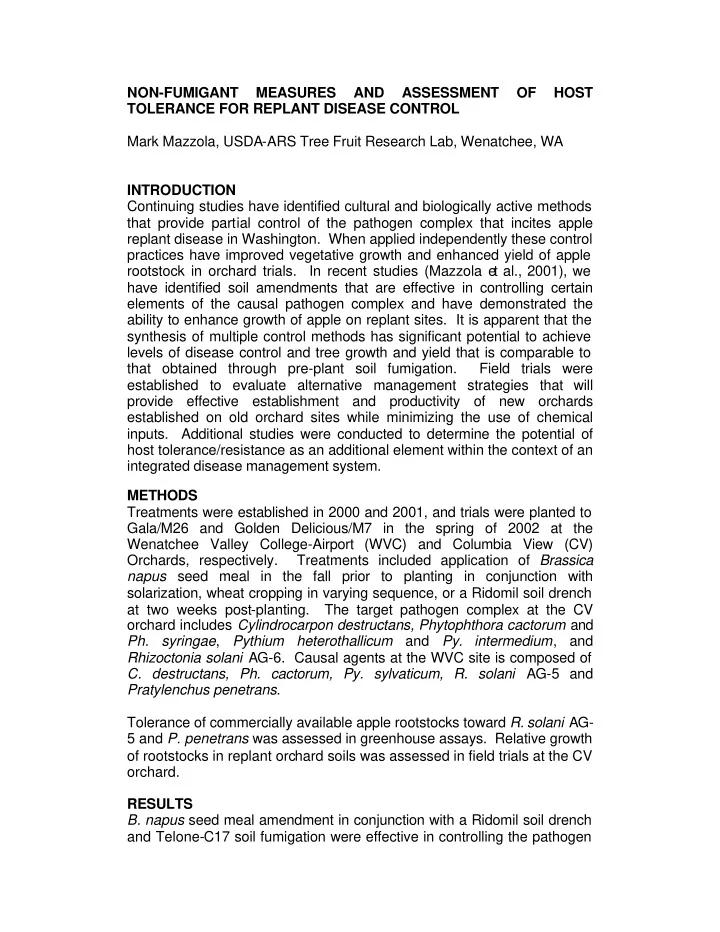

NON-FUMIGANT MEASURES AND ASSESSMENT OF HOST TOLERANCE FOR REPLANT DISEASE CONTROL Mark Mazzola, USDA-ARS Tree Fruit Research Lab, Wenatchee, WA INTRODUCTION Continuing studies have identified cultural and biologically active methods that provide partial control of the pathogen complex that incites apple replant disease in Washington. When applied independently these control practices have improved vegetative growth and enhanced yield of apple rootstock in orchard trials. In recent studies (Mazzola e t al., 2001), we have identified soil amendments that are effective in controlling certain elements of the causal pathogen complex and have demonstrated the ability to enhance growth of apple on replant sites. It is apparent that the synthesis of multiple control methods has significant potential to achieve levels of disease control and tree growth and yield that is comparable to that obtained through pre-plant soil fumigation. Field trials were established to evaluate alternative management strategies that will provide effective establishment and productivity of new orchards established on old orchard sites while minimizing the use of chemical inputs. Additional studies were conducted to determine the potential of host tolerance/resistance as an additional element within the context of an integrated disease management system. METHODS Treatments were established in 2000 and 2001, and trials were planted to Gala/M26 and Golden Delicious/M7 in the spring of 2002 at the Wenatchee Valley College-Airport (WVC) and Columbia View (CV) Orchards, respectively. Treatments included application of Brassica napus seed meal in the fall prior to planting in conjunction with solarization, wheat cropping in varying sequence, or a Ridomil soil drench at two weeks post-planting. The target pathogen complex at the CV orchard includes Cylindrocarpon destructans, Phytophthora cactorum and Ph. syringae , Pythium heterothallicum and Py. intermedium , and Rhizoctonia solani AG-6. Causal agents at the WVC site is composed of C. destructans, Ph. cactorum, Py. sylvaticum, R. solani AG-5 and Pratylenchus penetrans . Tolerance of commercially available apple rootstocks toward R. solani AG- 5 and P. penetrans was assessed in greenhouse assays. Relative growth of rootstocks in replant orchard soils was assessed in field trials at the CV orchard. RESULTS B. napus seed meal amendment in conjunction with a Ridomil soil drench and Telone-C17 soil fumigation were effective in controlling the pathogen
complex that was targeted at the WVC and CV Orchards. Over the initial 2-year life span of the CV orchard, growth of Gala/M26 planted in seed meal/Ridomil treated soil has been equivalent to that of trees established in fumigated soil. In addition, initial yields from trees receiving this alternative treatment has exceeded that obtained in response to soil fumigation (Table 1). Wheat cropping followed by seed meal amendment and solarization also enhanced tree growth relative to the control, but both were inferior to soil fumigation. At the WVC orchard, 16-month growth of Golden Delicious/M7 has been enhanced relative to the non-treated control by all alternative treatments evaluated, with the exception of soil solarization. However, alternative treatments have provided a growth response that is inferior to that obtained with pre-plant soil fumigation. Apple rootstocks exhibited considerable difference in tolerance toward the fungal pathogen R. solani AG-5 (Table 2). Among the rootstocks evaluated, M.7 and Bud.9 were consistently the most susceptible, regardless of the soil in which assays were conducted, and tree death was commonly observed. In contrast, Seedling and Geneva16 rootstocks exhibited the greatest tolerance to this pathogen. Geneva16 has also demonstrated significant tolerance/resistance to the lesion nematode, while M.9, MM106 and MM111 supported significantly higher populations of this plant parasitic nematode. DISCUSSION Findings from these field trials indicate that B. napus seed meal applied as a soil amendment in the fall prior to planting in conjunction with a post- planting application of the fungicide Ridomil has significant potential as an alternative to pre-plant soil fumigation for the control of apple replant disease. The post-plant fungicide application is required due to the increased activity of Pythium spp. in response to this soil amendment. The Malus germplasm has been shown to vary in tolerance to the biological complex which incites replant disease (Isutsa and Merwin, 2000). The current study has identified tolerance within commercially available rootstocks to specific elements of the causal disease complex. These findings indicate that host tolerance will be an important element to consider during the design of a systems approach to the management of apple replant disease. Isutsa, D. K., and Merwin, I. A. 2000. HortScience 35:262-268. Mazzola, M., Granatstein, D. M., Elfving, D. C., and Mullinix, K. 2001. Phytopathology 91: 673-679.
Table 1. Impact of pre-plant soil treatment on yield of Gala/M26 established on a replant site at the Columbia View Research and Demonstration Orchard in May 2002 Treatment 2003 Yield (kg fruit/tree) 0.00a z Control TeloneC17 0.83b B. napus meal/Ridomil 2.89c Wheat/ B. napus meal 0.42ab Solarization 0.23ab z Values followed by the same letter are not significantly ( P =0.05) different. Table 2. Relative tolerance of selected apple rootstocks to Rhizoctonia solani AG-5 and Pratylenchus penetrans as assessed by growth relative to that obtained in the absence of the pathogen or root populations P. penetrans (#/g root) Rootstock % (growth in the presence of R. solani relative to the control) 151b z Seedling 113 Bud.9 51 76ab Geneva16 103 23a ND M.7 55 M.9 100 362c M.26 41 ND MM106 67 621d MM111 72 484cd z Values followed by the same letter are not significantly ( P =0.05) different. ND=not determined.
Recommend
More recommend